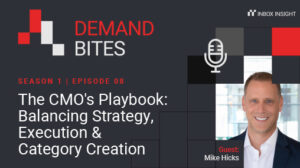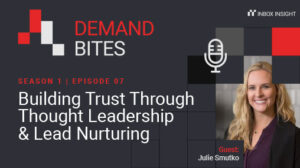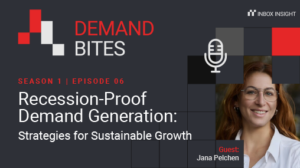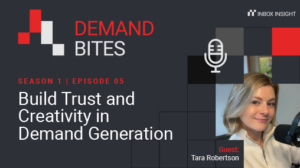Lead generation isn’t just about generating leads; it’s about generating quality leads – an essential activity for B2B marketing and sales teams. It’s the process of identifying the ideal customers for your product or service, then attracting them to make a purchase.
Some companies focus solely on acquiring new leads through outbound activities such as cold emails or prospecting, while others use inbound tactics such as inbound marketing, content creation and social media outreach. Regardless of how you choose to generate leads, it’s important to remember that no single approach works for every business.
In this article we’ll explore:
-
- Why B2B lead generation remains an essential marketing strategy
- How to turn data into actionable intelligence
- Leading lead generation processes and tools
- Best practices for measuring lead gen performance
Reading time: 8 minutes
What is B2B lead generation?
In the world of B2B marketing, lead generation encompasses much more than simply identifying prospective customers. It includes the entire lifecycle of selling to those prospects — including nurturing leads into qualified opportunities, converting leads into closed deals, and managing the post-sale relationship.
In its simplest form, lead generation is about capturing and stimulating the interest of buyers and involves collecting a potential customer’s information — such as name, email, company name, and job title — and then using that information to target them with customized sales pitches or ad campaigns.
In its most advanced form, lead generation leverages AI powered technologies such as predictive analytics to drive hyper targeted marketing campaigns to audiences matching your Ideal Customer Profile (ICP) criteria and displaying high intent behaviors.
Overall, lead generation is a critical part of every B2B marketing strategy, and one that requires careful planning and execution. Without an effective B2B lead generation process, delivering the right volume of high quality qualified leads into your sales teams, overreliance on additional channels such as sales outreach can drastically impact your sales velocity.
Types of B2B leads
B2B leads are people and organizations identified by your business that have the potential to become customers. Qualified leads are leads who meet a range of pre-defined criteria and who have shown interest in your brand, product or service.
Every effective B2B lead generation strategy requires an understanding of MQLs, SQLs and SALs to determine how leads are moving through the customer journey. To do this, understanding the different stages of the sales and marketing funnel is key:
1. Marketing Qualified Lead (MQL)
Leads that fit your buyer persona and ICP criteria are defined as Marketing Qualified Leads (MQLs). These are leads that score highly against specific attributes, characteristics and data points defined in your lead scoring model and which help signal their readiness to buy. Once qualified, these leads can be further nurtured and converted into paying customers.
Learn more: Demand Generation Masterclass: How to Follow Up MQLs
2. Sales Qualified Lead (SQL)
When MQLs are qualified by sales teams as having strong buying intent, they are said to be Sales Qualified. Distinguishing between Marketing Qualified and Sales Qualified allows sales teams to prioritize and focus on those leads that are most likely convert.
This approach is useful, especially in situations where products have longer sales cycles and where nurturing the wrong leads can negatively impact conversion rates. SQLs are qualified and scored on predefined criteria — similar to MQLS, but it’s the job of sales to vet each lead and qualify it accordingly using one of the many frameworks available: BANT, MEDDICS, CHAMPS and so on.
3. Sales Accepted Lead (SAL)
Not every company finds it necessary to include a Sales Accepted Lead (SAL) status within their sales funnel. Often its purpose is to give feedback to the marketing team on the quality of the leads being generated but when it’s accompanied with a clear acceptance process and SLA, it can also protect the most valuable leads from degrading over time.
Sales accepted leads are moved to sales qualified once the salesperson has engaged with the prospect and deemed it a worthwhile account to pursue.
The importance of lead generation for B2B
Lead generation is a crucial component of any B2B sales and marketing strategy. Developing a strong lead generation process provides a number of key benefits:
-
- Drives new sales opportunities – The main goal of lead generation is to create new prospects for your business. By nurturing leads through the sales funnel, you can convert them into paying customers and generate more revenue. Lead generation trends, such as the increasing focus on AI-driven lead scoring and personalized content, are shaping the way businesses identify and engage with potential customers.
- Builds a pipeline of potential clients – A constant influx of new leads creates a full pipeline of prospects at different stages of the funnel. With lead nurturing, you can develop promising leads into sales-ready opportunities over time. This ensures you always have potential deals in the pipeline to meet your sales goals.
- Increases brand awareness – The lead generation process raises awareness of your brand as prospective customers interact with your content, sales team, and campaigns. This expands your reach and establishes your market authority. More exposure means potential leads already know about you when your sales team contacts them.
The importance of data in lead gen
As digital marketing has evolved, so has the need for harvested and actioning data. As potential leads go about their lives online, they leave digital footprints about their preferences, likes, dislikes and where they are in their purchasing journey. This information is referred to as Intent Data. It is behavioral information collected about what individuals and businesses are interested in – what they are researching and reading online, signaling where they are in their decision-making process. The more you know about where your B2B buyers are in their journey, the more you can personalize their experience by serving up content that better meets their needs.
The reality is not all leads are good leads – some have a higher potential deal value than others, some are already researching your products, while others have no interest in buying. The benefit of intent-based lead generation is you have more control over who sees your content, tailoring messages not only to demographics and interests but also to where those people are in their journey and which are most likely to convert.
Turn data into intelligence
For successful B2B lead generation, good quality data is a must. It’s not just about who to target, it’s also important to collect and analyze data that helps you to determine the best way to connect with your audience and with what content. Engaging prospects with information that’s relevant to them at the right time in their journey improves customer relationships and creates brand loyalty.
If your marketing and account data is inaccurate or incomplete then it becomes much harder to create and promote content that converts. If you are collecting the right data from your campaigns you are also much better placed to test and iterate to continually improve the way in which you approach your demand generation efforts.
How does B2B lead generation work?
There are many different ways to generate leads for your business, but the right method will depend on your business. Before we get into the different strategies, it’s important to distinguish between outbound and inbound strategies.
Inbound marketing
Inbound marketing relies on the creation of valuable content and campaigns that attract visitors to your website in order to convert them into leads. The buyer controls the timeframe and channel of the engagement which could be via a search engine, social media or ad exchange platform. Typically, they exchange their email address or contact details in return for a valuable piece of content or attendance at a virtual event or webinar that will fulfil their information need. This is normally the start of their journey. Effective lead gen campaigns then go on to nurture and build on this engagement.
By helping your B2B buyers to research and solve their problems and by demonstrating an understanding of their pain points and needs, inbound lead generation gives the contact more control over their interactions with your brand helping to create an overall positive experience. Consequently, they are considered a warm lead and, providing they match your ICP criteria, are more likely to convert.
Inbound marketing tactics include:
-
- Content marketing
- Thought leadership
- Content syndication
- SEO
- Lead nurturing
- Re-marketing
- Social media marketing
- Programmatic advertising
Outbound marketing
Outbound marketing, also known as interruption marketing, refers to any kind of marketing where the company starts the conversation. This could be through TV advertising, trade shows, cold calling or emailing – the key is that the company, not the potential customer, has initiated contact. Outbound prospecting remains an effective lead generation practice for B2B businesses and when coupled with solid account research and greater levels of personalization, it’s a great compliment to inbound strategies.
A five-step B2B lead generation process
Today there are a myriad of ways to generate leads in B2B marketing. Not every strategy works for every business, but follow this process and you will have created a basic lead generation engine that you can start to evolve and optimize over time.
Step 1 – Research your target market
The first step in any lead generation campaign is to have a thorough understanding of your target audience.
In B2B, this needs to happen at both a contact and company level. At a contact level this is known as a buyer persona and covers what they do, their industry, job title, the challenges they face on a day-to-day basis – detailed buyer personas allow you to create campaigns that better connect with your potential buyers. At a company level, an ICP provides a description of an ideal business representing the type of company that benefits the most from purchasing your product.
When you are developing your buyer personas and ICP, it’s helpful to understand what keywords and phrases they are using to discover the content and products they are searching. That way, you are able to create content that answers their questions and provides solutions to their problems.
To help you develop your personas download our Guide to Persona Planning and DMU Persona Builder Cheat Sheet.
Or grab this ICP profile planner template.
Step 2 – Promote content across your business channels
Now you have content, you will want to get it into the hands of your target customers. The key to channel selection is knowing which channels are most effective for your particular audience. You’ll want to test both paid and organic channels including PPC search and display ads, as well as social channels including Facebook, Instagram, Twitter, LinkedIn, TikTok, your blog, or wherever your customers are most active.
Step 3 – Personalize touchpoints
Personalization is key to improving lead generation quality. By targeting customers with personalized, relevant content that targets their interests, purchase requirements and is based on where they are in their buyer journey can help to improve lead quality.
Customizing the engagement demonstrates that you know what your customer base wants and are willing to take the time to address their concerns on an individual level. Personalize your offers, email marketing and product recommendations – use first names in subject lines to encourage higher open rates and engagement and analyze how a prospect interacts with your content to gain insight about their future purchasing intent.
Step 4 – Score and nurture leads
Not all leads are at the same stage of their buying journey. If a potential customer has downloaded just one piece of content it may not be a purchase intent signal so you may want to enroll different leads into specific nurturing programs based on their attributes before you pass them to sales. Multi touch marketing campaigns offer a great opportunity for additional personalization. The key is to create content that builds trust by addressing your specific buyers’ pain points as you guide them through the sales funnel towards purchase. Then use lead scoring to indicate to sales which leads are ‘sales ready’ and therefore most likely to convert.
AI lead scoring tools can greatly enhance the effectiveness of your lead generation efforts. These advanced tools analyze various data points to accurately determine the quality and intent of each lead. By utilizing AI, you can streamline your lead nurturing process – saving valuable time and resources. What’s more, with the ability to prioritize leads based on their likelihood to convert, AI ensures that your sales team focuses their efforts where they will have the greatest impact.
Step 5 – Evaluate your lead generation process
Review your process regularly. Look to identify where leads may be dropping out of your funnel or going cold. Leverage all of the analytics tools available to you such as Google Analytics or any advertising platforms you may be using to determine whether benchmarks are being met and if customers are being driven down the sales funnel effectively.
Lead generation strategies to generate sales leads
If you are just starting out with inbound lead generation, then you will want to brush up on your content marketing skills. For your inbound lead generation to work, every B2B company needs great content and a solid content marketing strategy that can drive relevant traffic to your website. By understanding what type of content resonates with your target audience, you can develop a successful content marketing strategy that will generate B2B sales leads. Let’s dive into the mechanics.
1. Create gated content to capture leads
A bedrock of any content marketing strategy is gated content. Offering something valuable like a whitepaper or eBook in exchange for information from your prospects such as their name, email address and industry is a great way to build trust, gather information, and generate B2B leads. These valuable resources are often referred to as lead magnets.
Another option is to use sponsored posts or search and display ads to drive potential customers to a dedicated landing page which can further qualify the lead and collect information.
2. Repurpose your content
Content can be expensive and time-consuming to create so ensure you are making the most out of every piece of content you produce. Repurpose your content for different channels and audiences. Turn whitepapers into infographics, webinars into short form explainer videos, summarize blogs into YouTube videos, and repurpose existing video content for different platforms.
Repurposing content can help your marketing team maximize demand generation results while saving valuable time and money. It also guarantees that your audience can consume the content in the format they prefer, via the channel best suited to them.
3. Search Engine Optimization (SEO)
Optimizing your website and content for search engines like Google is critical for being discoverable to prospects searching for solutions online. On-page optimization, quality backlinks and local SEO help improve website visibility and traffic. You should update website copy, meta descriptions and titles to align with target keywords.
4. Use Programmatic Display Ads
Programmatic advertising uses AI to automate the process of buying and selling digital advertising space. It uses real-time data to dynamically place ads on relevant websites. The use of AI in programmatic helps to generate data-rich intelligence about the performance of your campaigns and provides actionable insights into your target audience and their buying patterns. This gives B2B marketers the opportunity to deliver ever more personalized advertisements to their prospects in order to capture more leads.
5. Pay-Per-Click (PPC) and Google Ads
Pay-per-click lead generation is the process of generating leads through pay-per-click advertising. B2B brands advertise on search engines such as Google and Bing to drive highly targeted traffic to content rich pages that have been carefully constructed to drive high quality conversion. Search advertising is often thought to be a quick but not inexpensive way to generate quick results when it comes to intercepting leads at crucial touchpoints in their purchase research phase.
6. LinkedIn
In recent years, Linkedin has become a go-to platform for B2B lead generation, not least because it allows B2B marketers the opportunity to pursue both inbound and outbound strategies, paid and organic on one platform.
LinkedIn’s paid advertising strategies include sponsored posts and media rich ad formats. One of the most significant benefits of creating display ads on LinkedIn is the ability to hone in on your target audience based on their job title, seniority, interests, geography, group membership and other important attributes, which helps make it one of the most effective channels for driving high-quality leads.
It’s also a great way to share social proof such as testimonials and cases studies either organically or via its paid network.
7. Facebook lead ad campaigns
It’s easy to overlook Facebook as a B2B lead generation channel but many consumers use Facebook in a professional capacity also.
Like LinkedIn it’s possible to create lookalike and interest-based audiences, and to split test campaigns to gauge which content is working hardest for you and generating the most leads. Whether you’re looking to promote content, drive product demos or gather free trial sign-ups, lead ads on Facebook can be fast and simple to set up and can generate high volumes of quality B2B leads for your business.
8. Retarget & remarket website visitors
Retargeting is a great way to remarket to customers who have already visited your website to maximize conversions from your paid and organic marketing. It works by tracking visitors to your site and then showing them paid ads on another website in an effort to bring them back to your site.
9. Combine ABM with Inbound
Account-Based Marketing (ABM) is a B2B marketing growth strategy that targets your best-fit customers and accounts with personalized content and campaigns to capture their attention and turn them into customers. Whereas inbound marketing goes broad, ABM focuses on delivering personalized experiences to a much smaller group of potential high value customers in order to maximize revenue opportunities. By leveraging the strengths of ABM and inbound marketing, you can create a comprehensive approach that not only casts a wide net but also delivers tailored messages to your most valuable prospects.
10. Work closely with your sales team
Sales and marketing alignment can make or break your lead generation strategies. Businesses with aligned sales and marketing teams generate over 200% revenue growth from marketing tactics, are more than two-thirds (67%) more effective at closing deals and see 24% faster growth in revenue.
Ensuring B2B marketers are working in unison with sales can be difficult, but it’s not impossible! Below are 5 ways to build unity across the two teams:
-
- Set out clear roles and responsibilities to ensure accountability
- Regular meetings to communicate areas of concern and stay in sync with one another
- Share reports and analysis when it’s relevant, insightful and could help the other team
- Marketing to create ample amounts of new content and communicate when it’s live, along with a summary of its key takeaways
- Shadow one another to observe how each effort contributes to shared goal of revenue
B2B lead generation tools
To execute an effective lead generation strategy, you need the right tools and software. Here are some of the key tools for B2B lead generation success:
| CRM Software | A CRM (Customer Relationship Management) system is essential for tracking your leads and interactions. It will store all lead contact information and history in one centralized place. Popular CRM platforms include: Salesforce and HubSpot. |
| Marketing Automation Platforms | Marketing automation helps you nurture your leads through email sequences, landing pages, forms, and workflows. Leading platforms include: HubSpot Marketing Hub, Pardot, Marketo. |
| Analytics Tools | Analytics provide visibility into your lead generation performance. You can analyze traffic sources, lead quality, conversion rates, and more. Top options include: Google Analytics, Mixpanel, Heap Analytics. |
| SEO Tools | SEO is critical for inbound lead generation. SEO tools help with keyword research, site audits, rank tracking, and more. Useful SEO tools include: Ahrefs, SEMrush, Search Console. |
| Social Media Management Tools | For social media lead generation, social media management tools like Hootsuite and Sprout Social make it easy to schedule content, engage followers, and analyze performance. |
If you’re considering outsourcing your lead generation efforts, it’s crucial to ask the right questions to lead generation companies. For instance, inquire about the strategies they employ to generate leads and request examples of successful lead generation campaigns they’ve executed in the past.
Measuring B2B lead gen success
To determine if your efforts are successful, you need to track key metrics and continuously optimize based on the data. Here are 6 key metrics for measuring the performance of your B2B lead generation campaigns:
-
- Lead volume: The number of new leads generated in a given period. Track both total leads and leads by source. [Try our MQL volume calculation tool here]
- Lead quality: Percentage of leads that fit your ideal customer profile. Assess lead quality through lead scoring and MQL qualification rate.
- Lead velocity: Time it takes to progress a lead through the sales funnel.
- Cost per lead: Calculate by dividing total lead generation costs by number of leads.
- Conversion rates: Percentage of leads that convert into sales opps, demos, deals closed.
- Lifetime value: Total revenue generated from a lead over the lifetime of that customer.
Calculating ROI
Return on investment (ROI) measures profit generated per dollar spent. To calculate:
ROI = (Gain from investment – Cost of investment) / Cost of investment
For lead generation, gain is lifetime revenue from converted leads and cost is your spending on lead gen activities.
Benchmarking performance
Compare your metrics to industry benchmarks to better evaluate your lead gen program. Benchmarks can include:
-
- Lead to opportunity conversion rate: 10-30%
- Lead to customer conversion rate: 2-5%
- Cost per lead: $50-$200 for inbound, higher for outbound
Continuously test and optimize to improve your lead gen ROI and hit key benchmark targets.
Grow your sales pipeline with Inbox Insight
Our cutting-edge lead gen approach leverages data science and AI capabilities to deliver predictive targeting. This enables us to match your ICP or target account lists (TAL) to real tech buyers demonstrating high intent to purchase.
We then execute precision led multichannel campaigns on your behalf to intercept buyers at crucial touchpoints in their buying process.
Find out more about our lead generation services or speak to one of our specialists today.






